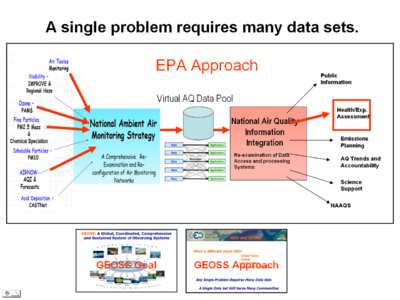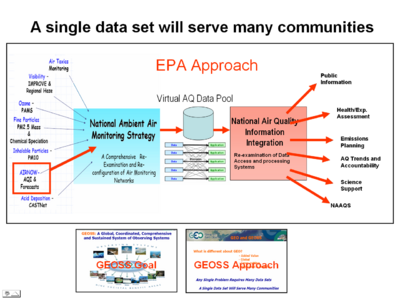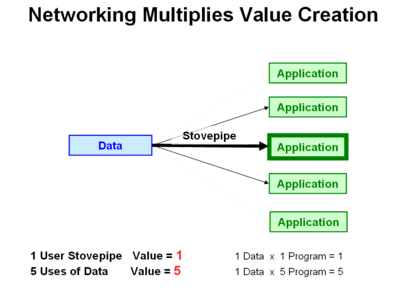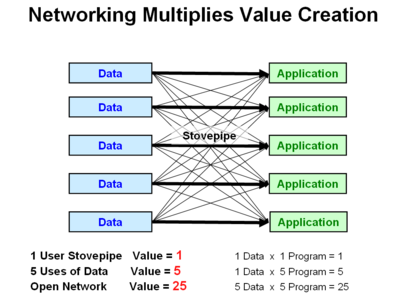Difference between revisions of "Networking of Air Quality Data"
| Line 26: | Line 26: | ||
==Related topics: == | ==Related topics: == | ||
| + | * [[AirNOW Data System Design Topics]] | ||
* [[On_Decision-Support_System_Architectures|DSS Architectures]] | * [[On_Decision-Support_System_Architectures|DSS Architectures]] | ||
* [[Applications of AirNOW Data]] | * [[Applications of AirNOW Data]] | ||
* [[Evolution of the AirNOW Data System]] | * [[Evolution of the AirNOW Data System]] | ||
Revision as of 18:56, February 28, 2008
What links here: Networking of Air Quality Data
Background
The mission of the Environmental Protection Agency is to protect human health and the environment. Air quality management involves many activities including setting and maintaing air quality standards, monitoring trends, informing the public, etc. Each of these activities have different information needs. In the past both the monitoring and assessment of air quality has been performed in specific programs each directed and somewhat confined to the specific applications that they served.
Recently, the Agency developed and now is in the process of implementing a new National Air Monitoring Strategy(NAMS). NAMS was designed to produce more reusable datasets for multiple programs/applications in EPA. Implicit in the new strategy is that there is a corresponding new Information System strategy that facilitates the access, processing/analysis/integration of broad range of data applicable to multiple uses.
At the international level, the 70-nation Group on Earth Observations (or GEO) is coordinating international efforts to build a Global Earth Observation System of Systems (GEOSS). This emerging public infrastructure (system of systems) is interconnecting a diverse and growing array of instruments and systems for monitoring and forecasting changes in the global environment.
The common characteristics of both the planned EPA and GEOSS information systems are:
- A single problem requires many data sets.
- A single data set will serve many communities
The above two characteristics of the information system puts high demand on the architecture of the information system that facilitates the flow of the data resources from the providers to the users via a suitable data processing chain. An ingeneous solution to the many-to-many connections is illustrated schematically in the above "bow-tie" or fan in-fan out representation. The left hand side, fan in section, represents the collection of the distributed data resources into a common data access system, represented by the barrel. The potential users of the data, shown on the right hand side, satisfy their data by selecting from the common data pool. The fan out represents the fact that each user may need different combination of data and processing services.
It is recognized that creating a common database that collects all the relavent data and metadata into a single physical database is not practical. An alternative is the network approach where data and information services represent nodes in a network that can be dynamically connected to form user-driven data flow systems.
GEOSS, like the Internet, connects data/information providers and users; to deliver reliable, up-to-date and user friendly information – vital for the work of decision makers, planners and emergency managers. The GEOSS Approach is to build on existing systems, register and catalog reusable components provided voluntarily by the member organizations and to facilitate integration of these components through international standard interfaces.
Networking through the dynamic creation of loosely connected components has the potential to produce the well-known "Network Effect", where the value of the network increases in proportion to the number of network nodes squared. This non-linear behavior of producing overall value to the community is illustrated schematically below.



